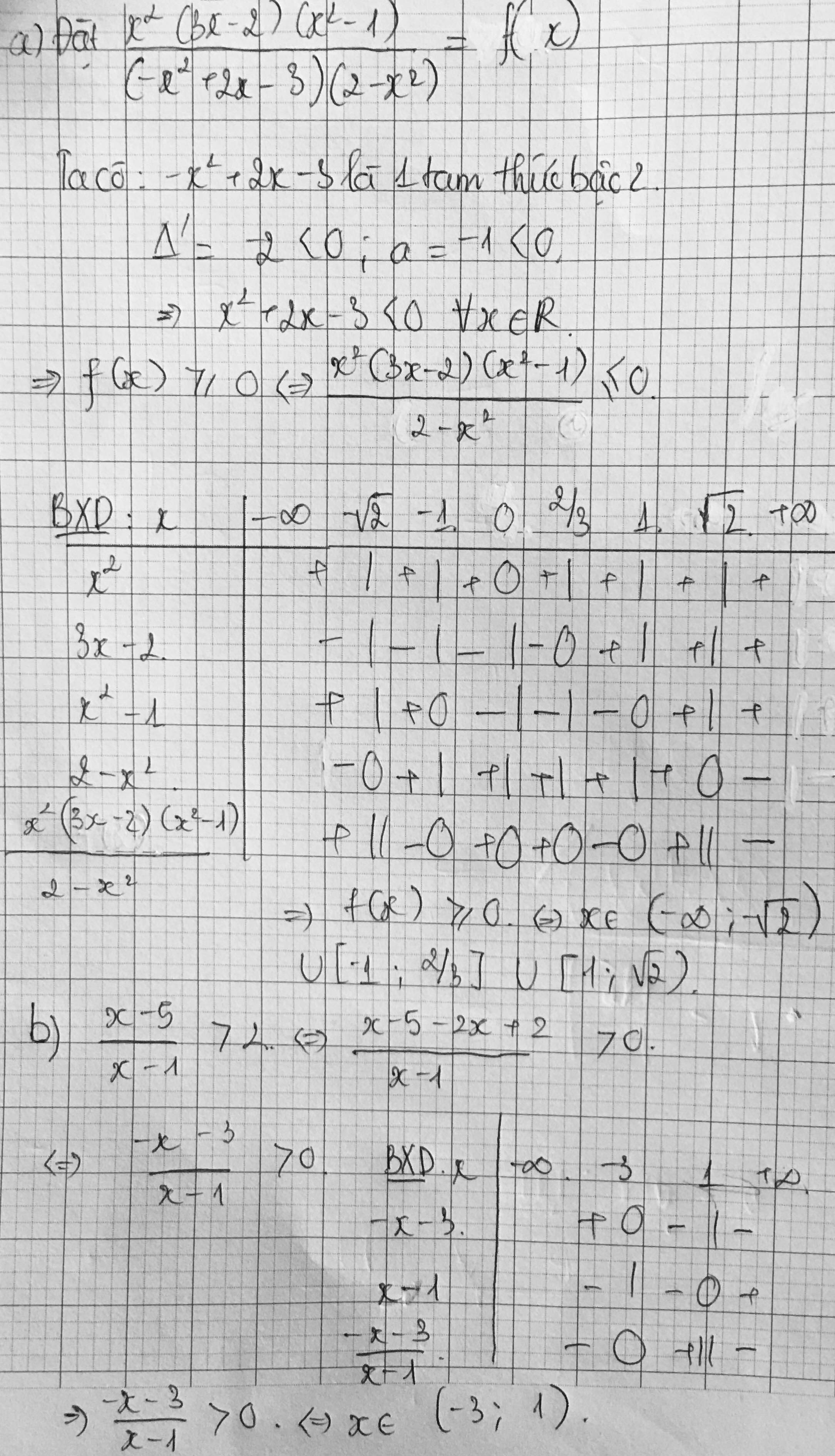Giải phương trình: \(\left(x^2-x+1\right)^4+4x^2\left(x^2-x+1\right)^2=5x^2\)
Hãy nhập câu hỏi của bạn vào đây, nếu là tài khoản VIP, bạn sẽ được ưu tiên trả lời.


`(x^2-x+1)^4+4x^4=5x^2(x^2-x+1)^2`
Đặt `a=(x^2-x+1)^2,b=x^2`
`pt<=>a^2+4b^2=5ab`
`<=>a^2-5ab+4b^2=0`
`<=>a^2-ab-4ab+4b^2=0`
`<=>a(a-b)-4b(a-b)=0`
`<=>(a-b)(a-4b)=0`
`<=>` $\left[ \begin{array}{l}a=b\\a=4b\end{array} \right.$
`+)a=b`
`<=>x^2=(x^2-x+1)^2`
`<=>(x^2+1)(x^2-2x+1)=0`
`<=>(x-1)^2=0` do `x^2+1>0`
`<=>x=1`
`+)a=4b`
`<=>x^2=4(x^2-x+1)^2`
`<=>x^2=(2x^2-2x+1)^2`
`<=>(2x^2-x+1)(2x^2-3x+1)=0`
`+)2x^2-x+1=0`
`<=>x^2-1/2x+1/2=0`
`<=>(x-1/4)^2+7/16=0` vô lý
`+)2x^2-3x+1=0`
`<=>2x^2-2x-x+1=0`
`<=>2x(x-1)-(x-1)=0`
`<=>(x-1)(2x-1)=0`
`<=>` $\left[ \begin{array}{l}x=1\\x=\dfrac{1}{2}\end{array} \right.$
Vậy `S={1,1/2}`

Câu 4:
Giả sử điều cần chứng minh là đúng
\(\Rightarrow x=y\), thay vào điều kiện ở đề bài, ta được:
\(\sqrt{x+2014}+\sqrt{2015-x}-\sqrt{2014-x}=\sqrt{x+2014}+\sqrt{2015-x}-\sqrt{2014-x}\) (luôn đúng)
Vậy điều cần chứng minh là đúng
2) \(\sqrt{x^2-5x+4}+2\sqrt{x+5}=2\sqrt{x-4}+\sqrt{x^2+4x-5}\)
⇔ \(\sqrt{\left(x-4\right)\left(x-1\right)}-2\sqrt{x-4}+2\sqrt{x+5}-\sqrt{\left(x+5\right)\left(x-1\right)}=0\)
⇔ \(\sqrt{x-4}.\left(\sqrt{x-1}-2\right)-\sqrt{x+5}\left(\sqrt{x-1}-2\right)=0\)
⇔ \(\left(\sqrt{x-4}-\sqrt{x+5}\right)\left(\sqrt{x-1}-2\right)=0\)
⇔ \(\left[{}\begin{matrix}\sqrt{x-4}-\sqrt{x+5}=0\\\sqrt{x-1}-2=0\end{matrix}\right.\)
⇔ \(\left[{}\begin{matrix}\sqrt{x-4}=\sqrt{x+5}\\\sqrt{x-1}=2\end{matrix}\right.\)
⇔ \(\left[{}\begin{matrix}x\in\varnothing\\x=5\end{matrix}\right.\)
⇔ x = 5
Vậy S = {5}

\(1,\dfrac{5x-1}{3}-1=2x+3\\ \Leftrightarrow\dfrac{5x-4}{3}=2x+3\\ \Leftrightarrow5x-4=3\left(2x+3\right)\\ \Leftrightarrow5x-4=6x+9\\ \Leftrightarrow6x+9-5x+4=0\\ \Leftrightarrow x+13=0\\ \Leftrightarrow x=-13\)
\(2,16x^2-3=\left(4x-3\right)\left(5x+1\right)\\ \Leftrightarrow16x^2-3=20x^2-15x+4x-3\\ \Leftrightarrow16x^2-3=20x^2-11x-3\\ \Leftrightarrow20x^2-11x-3-16x^2+3=0\\ \Leftrightarrow4x^2-11x=0\\ \Leftrightarrow x\left(4x-11\right)=0\\ \Leftrightarrow\left[{}\begin{matrix}x=0\\x=\dfrac{11}{4}\end{matrix}\right.\)
\(3,ĐKXĐ:x\ne\pm2\\ \dfrac{x-2}{x+2}-\dfrac{3}{x-2}=\dfrac{-x\left(15-x\right)}{x^2-4}\\ \Leftrightarrow\dfrac{\left(x-2\right)^2-3\left(x+2\right)}{x^2-4}=\dfrac{x^2-15x}{x^2-4}\\ \Leftrightarrow\left(x-2\right)^2-3\left(x+2\right)=x^2-15x\)
\(\Leftrightarrow x^2-4x+4-3x-6-x^2+15x=0\\ \Leftrightarrow8x-2=0\\ \Leftrightarrow x=\dfrac{1}{4}\left(tm\right)\)


a:Sửa đề: \(\dfrac{3}{5x-1}+\dfrac{2}{3-x}=\dfrac{4}{\left(1-5x\right)\left(x-3\right)}\)
=>3x-9-10x+2=-4
=>-7x-7=-4
=>-7x=3
=>x=-3/7
b: =>\(\dfrac{5-x}{4x\left(x-2\right)}+\dfrac{7}{8x}=\dfrac{x-1}{2x\left(x-2\right)}+\dfrac{1}{8\left(x-2\right)}\)
=>\(2\left(5-x\right)+7\left(x-2\right)=4\left(x-1\right)+x\)
=>10-2x+7x-14=4x-4+x
=>5x-4=5x-4
=>0x=0(luôn đúng)
Vậy: S=R\{0;2}

a) (x2 - 4x)2 = 4(x2 - 4x)
<=> (x2 - 4x)(x2 - 4x - 4) = 0
<=> x(x - 4)(x2 - 4x - 4) = 0
\(\Leftrightarrow\left[{}\begin{matrix}x=0\\x=4\\\left(x-2\right)^2=8\end{matrix}\right.\Leftrightarrow\left[{}\begin{matrix}x=0\\x=4\\x=\pm\sqrt{8}+2\end{matrix}\right.\)
b) (x + 2)2 - x + 1 = (x - 1)(x + 1)
<=> x2 + 4x + 4 - x + 1 = x2 - 1
<=> 3x + 5 = -1
<=> x = -2

Bài 4 :
24 phút = \(\dfrac{24}{60} = \dfrac{2}{5}\) giờ
Gọi thời gian dự định đi từ A đến B là x(giờ) ; x > 0
Suy ra quãng đường AB là 36x(km)
Khi vận tốc sau khi giảm là 36 -6 = 30(km/h)
Vì giảm vận tốc nên thời gian đi hết AB là x + \(\dfrac{2}{5}\)(giờ)
Ta có phương trình:
\(36x = 30(x + \dfrac{2}{5})\\ \Leftrightarrow x = 2\)
Vậy quãng đường AB dài 36.2 = 72(km)



@Nguyễn Thanh Hằng @@Nk>↑@ @Bonking
@Nguyễn Việt Lâm